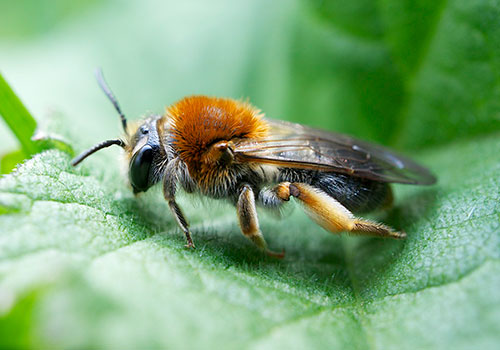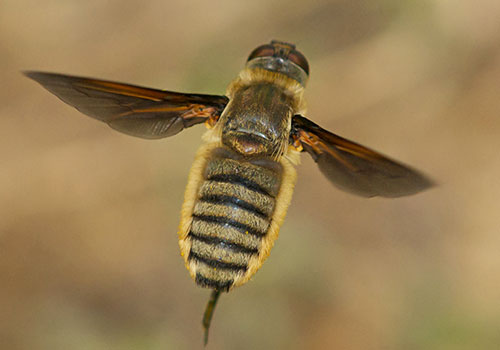Bee Or Not a Bee? A Guide to Flying Garden Friends
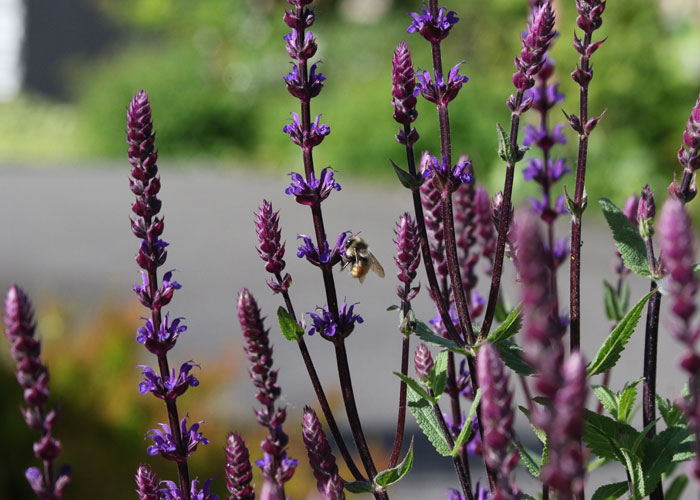
Gardeners know how important bees are to our gardens and our planet, and most of us welcome the ones we recognize. But for all their popularity, bees remain misunderstood.
Many people don’t realize just how diverse bees really are. Even many avowed bee-enthusiasts may only picture the classic black and yellow honey bees when they think “bees.” On the other hand, many other flying garden creatures are often mistaken for bees simply because they share similar body shapes or coloring. Bees even get an undeserved bad reputation in some circles because they are confused with their more assertive cousins, wasps and hornets.
Let’s clear up some common misconceptions and celebrate the amazing menagerie of flying insect friends that grace our gardens.
What exactly is a bee?
Let’s get scientific for just a moment. Bees all share a common ancestor with each other that they don’t share with their next closest relatives. In taxonomic terms, that makes them a clade (Anthophila, within the superfamily Apoidea, if you’re into that kind of thing).
Think of it like a family tree: siblings share genetic parents, cousins share genetic grandparents but not parents, and so forth. Bees can all trace their ancestry back to the same point on the evolutionary “family tree,” and you’d have to go higher up on the tree to find the ancestor they share with wasps and ants.
And just as siblings can be very different from each other, bees are wonderfully diverse! Most of us recognize honeybees, which originally come from Europe but can now be found around the globe, and we have at least some familiarity with their complex hive structure. Many of us also know and love our native bumblebees, and we may be aware that they make smaller nests underground rather than large hives.
There are also about 600 species of lesser-known solitary bees in Washington State. These bees don’t come together in large social groups, don’t produce anything resembling honey, and for the most part only meet up in pairs to mate. Many of them look so different from honey bees that most people don’t realize they are bees at all! Yet they are also some of the most effective pollinators, and some of the pollinators that currently most need our help.
If the taxonomic order Hymenoptera had a family reunion, social honey bees and bumble bees might find they had more in common with some of their “cousins” than with their more solitary “siblings”: All ants and many wasps and hornets share their collective lifestyle, while many of their fellow bees don’t.
That’s a bee?
With so many bee species flying around, many of them bearing hardly any resemblance to their most popular “siblings,” the honey bees, you probably have more bees in your garden than you think! You might even be alarmed by an unknown insect in our garden, when in fact it is a friendly and imperiled native bee. Here are just a few of the most common under-appreciated or misunderstood bees you might see:
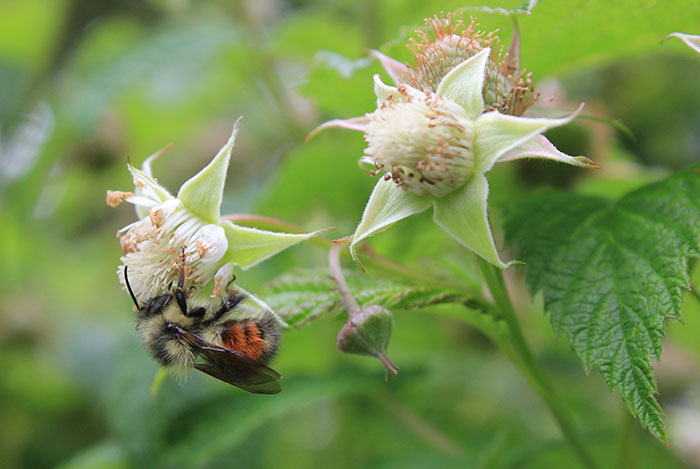 Bumble Bees || Many of us recognize bumble bees as among the fuzziest and friendliest of bees. Unlike honey bees, they are native in this region! But bumble bees still struggle under some common misconceptions.
Bumble Bees || Many of us recognize bumble bees as among the fuzziest and friendliest of bees. Unlike honey bees, they are native in this region! But bumble bees still struggle under some common misconceptions.
For one thing, not all bumblebees are black and yellow. Yellow-faced bumble bees (Bombus vosnesenskii) are probably the most commonly sighted species around here, and they have black bodies paired with yellow heads and a yellow stripe near their rear. But black-tail bumble bees (Bombus melanopygus, pictured above) are characterized by their russet-colored rumps, & fuzzy-horned bumble bees (Bombus mixtus) are almost entirely light-yellow.
Even bee-enthusiasts often mistake the very large bumble bees we tend to see in early spring/autumn as a different species than the much smaller ones seen in the summer. In fact, their size relates to their role within the nest: especially large bumble bees are queens and smaller ones are workers. They appear in seasonal cycles because of the unique life cycle of their nests.

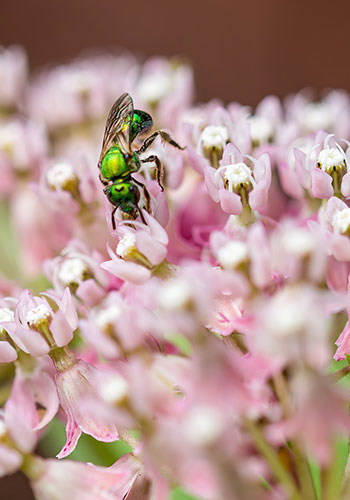
Mason Bees || Mason bees have started getting more credit for their effectiveness as early-spring pollinators, especially for fruit trees, for which they have earned the moniker "orchard bees." They are probably the most recognized solitary bee. Because they nest in cavities above ground, it's relatively easy to provide homes for them and even propagate them for sale. Mason bees are sometimes mistaken for flies, & are typically green, blue, or teal, with a metallic sheen.
Sweat Bees || These little bees collect pollen and nectar by climbing deep inside of flowers. You can often spot the heavy loads of yellow or orange pollen packed onto the hind legs of these hardworking, tiny insects. Many people don’t notice them at all because of their size. When they are noticed, they’re often mistaken for flies because they are usually black or gray, sometimes with a dusting of light-colored hairs. Their somewhat unflattering name comes from their occasional attraction to the salts in sweat.
Photo: Wikimedia Commons - Ian Kirk (click for link)
Mining Bees || Typically a little larger and fuzzier than sweat bees, these ground-nesting solitary bees also carry noticeable loads of pollen on their hind legs. Their midsections are often covered in light-colored hairs, and their abdomens are typically striped. Other than bumblebees, they are one of the most effective pollinators for blueberries.
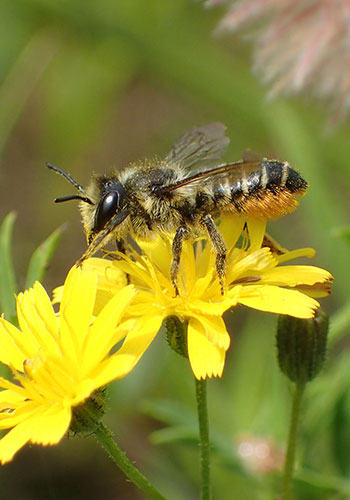
Leafcutter Bees || Aptly named, these solitary bees use their mandibles to cut sections of leaves or flowers. They lay their eggs inside of naturally-occurring holes in logs, and they use these plant bits to create divisions between each egg’s cell within their hole. They can cause a small amount of superficial damage to plants, but they are also important pollinators. They are usually black, sometimes with pale furry stripes, and they carry pollen underneath their abdomens instead of on their legs.
Photo: Wikimedia Commons - Charles J. Sharp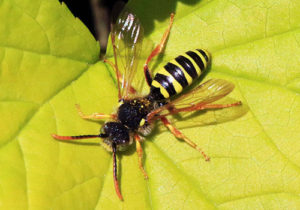
Cuckoo Bees || These mischievous native bees are nest parasites, meaning that they lay their eggs within the nests of other bee species. Mother cuckoo bees don’t need to collect pollen for their young, since the mothers of their hosts will take care of that. But they still provide pollination as they forage for themselves. Their black and yellow bodies are often almost hairless, so they can easily be mistaken for wasps.
That’s not a bee?
There are also quite a few creatures flying around our gardens that may be mistaken for bees but are actually flies or wasps. Here are a few you might see this year:
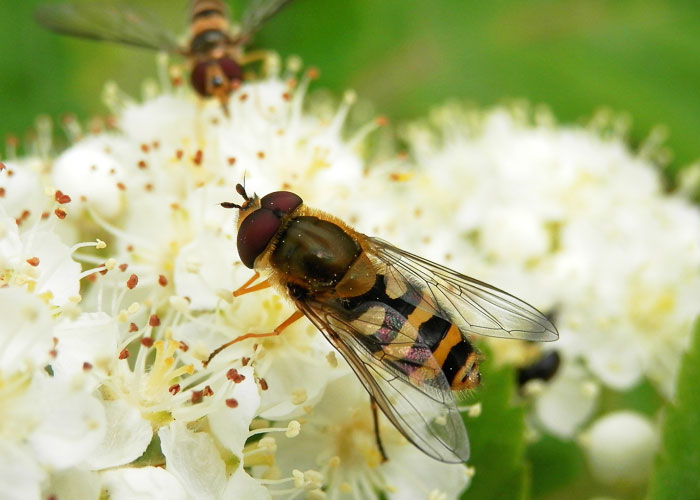
Syrphid Flies || Also known as “hover flies,” these unique flies can be recognized by their ability to stay in the air without flying forward. They are yellow and black like some bees, but no bee can compete with their tricky flying moves!
If you see syrphid flies hovering and zipping around your garden, don’t forget to thank them: These are incredibly helpful garden friends. The adults are pollinators, and their larvae are voracious predators that eat up all kinds of garden pests. To attract these beneficial insects, make sure there is always something in bloom in your garden throughout the spring, summer, and fall. Parsley flowers are among their favorite foods, along with calendula and yarrow.
Photo: Flickr - John McCullough
Bee flies || Just because it is fuzzy and flying around your flowers, that doesn’t mean it’s a bumblebee. It might be a bee fly instead! Look for brown instead of black, yellow, or orange colors, and a habit of hovering in mid-air. While perhaps not quite as charismatic as their look-a-likes, bee flies are still important native pollinators.
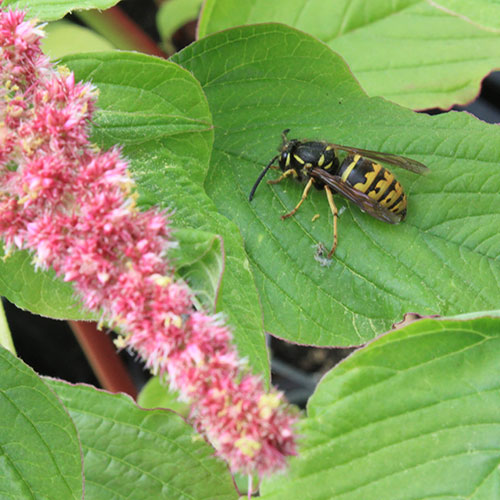
Yellow Jackets & Bald-Faced Hornets || Yellow jackets in particular are often mistaken for honey bees because they share a similar black and yellow pattern. And those who associate bees with bee stings may mistakenly lump social bees and social wasps together. Wasps and hornets do have a lot in common with their close bee cousins, but they also have some important differences.
Whereas bee larvae eat nectar and pollen just like their parents, wasp and hornet larvae eat meat. This means that these species provide important pest-control services as well as pollination. They are also much more aggressive than bees, so don’t blame bees if you get stung by a wasp! Despite not loving them as picnic guests, we still think they deserve a second chance.
Even if you aren’t entirely convinced about whether the benefits of these bee-cousins outweigh the trouble they bring, we hope you’ll take the time to notice and appreciate the huge diversity of insect life in your garden this year. See how many species you can spot!
For more information, visit the Xerces Society for Invertebrates at xerces.org

